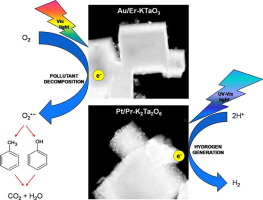Journal of Catalysis ( IF 6.5 ) Pub Date : 2018-06-21 , DOI: 10.1016/j.jcat.2018.05.013 Anna Krukowska , Grzegorz Trykowski , Wojciech Lisowski , Tomasz Klimczuk , Michal Jerzy Winiarski , Adriana Zaleska-Medynska

|
New, monometallic nanoparticles (MNPs) decorated surface and rare earth (RE) ions doped lattice of perovskite-type (KTaO3)/pyrochlore-type (K2Ta2O6) photocatalysts were successfully prepared by facile hydrothermal incorporation of RE ions into KTaO3/K2Ta2O6 lattices followed by photodeposition of MNPs. The impact of noble metal type (MNPs = Au, Pt, Rh) and rare earth dopant type (RE = Er, Pr) on the physicochemical properties correlated with photoactivity of MNPs/RE-KTaO3 and MNPs/RE-K2Ta2O6 has been examined. All as-prepared photocatalysts were systematically characterized by UV–vis diffuse reflectance spectroscopy, photoluminescence emission spectroscopy, transmission electron microscopy, energy-dispersive X-ray spectroscopy, fast Fourier transform, powder X-ray diffraction, and X-ray photoelectron spectroscopy. The crystal structure was presented using VESTA software. Photocatalytic activity of samples under visible light irradiation was determined by pollutant decomposition, while UV–vis induced activity was estimated by H2 generation efficiency. The experimental results suggested a synergistic effect between MNPs and RE-ions-modified KTaO3/K2Ta2O6, which resulted in greatly improved photocatalytic performance compared with that of pristine KTaO3/K2Ta2O6. Inclusion of RE ions into KTaO3/K2Ta2O6 lattices probably leads to formation of RE4f states below the conduction band levels to electron transition by lower photon excitation energy, while photoreduction of MNPs on the RE-KTaO3/RE-K2Ta2O6 surface causes localized surface plasmon resonance and activates surface by adsorption for both O2 and H2O molecules. The highest visible-light-induced photoactivity was observed for the Au/Er-KTaO3 sample (16.48%) in phenol solution degradation and for the Pt/Pr-K2Ta2O6 photocatalyst (36.13%) in gaseous toluene removal, respectively. Active species-trapping tests indicate that O2− radicals are meaningfully involved in phenol oxidation under visible light irradiation. The largest amount of H2 evaluation was observed for the Pt/Pr-K2Ta2O6 sample (93.16 µmol/min) under UV–vis irradiation, which also showed a relatively good lifetime in recycling. The present study describes noble- and rare-earth-metal-modified KTaO3/K2Ta2O6 as an advanced material in photocatalysis.
中文翻译:

装饰有单金属纳米粒子和稀土离子掺杂的KTaO 3 / K 2 Ta 2 O 6光催化剂,具有增强的污染物分解和改善的H 2生成能力
钙钛矿型(KTaO 3)/烧绿石型(K 2 Ta 2 O 6)光催化剂的表面修饰和稀土(RE)离子掺杂晶格是通过将稀土离子容易地水热掺入而成功制备的。 KTaO 3 / K 2 Ta 2 O 6晶格,然后进行MNP的光沉积。贵金属类型(MNPs = Au,Pt,Rh)和稀土掺杂剂类型(RE = Er,Pr)对与MNPs / RE-KTaO 3和MNPs / RE-K 2 Ta 2的光活性相关的理化性质的影响Ø 6已经检查过了。通过紫外可见漫反射光谱,光致发光发射光谱,透射电子显微镜,能量色散X射线光谱,快速傅里叶变换,粉末X射线衍射和X射线光电子能谱系统地表征了所有制备的光催化剂。使用VESTA软件显示晶体结构。可见光照射下样品的光催化活性由污染物的分解决定,而紫外可见诱导的活性则由H 2的产生效率来估计。实验结果表明,MNPs与RE离子修饰的KTaO 3 / K 2 Ta 2 O 6具有协同作用。与原始KTaO 3 / K 2 Ta 2 O 6相比,大大改善了光催化性能。将RE离子包含在KTaO 3 / K 2 Ta 2 O 6晶格中可能会导致在较低的导带能级形成RE4 f态,并通过较低的光子激发能使电子跃迁,同时RE-KTaO 3 / RE-上的MNP进行光还原。K 2 Ta 2 O 6表面引起局部表面等离子体共振,并通过吸附O 2和H 2活化表面O分子。在苯酚溶液降解中,Au / Er-KTaO 3样品的可见光诱导的光活性最高(16.48%),在除去甲苯中的Pt / Pr-K 2 Ta 2 O 6光催化剂中的可见光诱导的光活性最高(36.13%),分别。活性种捕获测试表明ö 2 -基团切实参与苯酚氧化可见光照射下。对于Pt / Pr-K 2 Ta 2 O 6,观察到的H 2评估量最大。样品(93.16 µmol / min)在紫外可见光照射下,在循环中也显示出相对较好的使用寿命。本研究描述了贵金属和稀土金属改性的KTaO 3 / K 2 Ta 2 O 6作为光催化中的高级材料。











































 京公网安备 11010802027423号
京公网安备 11010802027423号